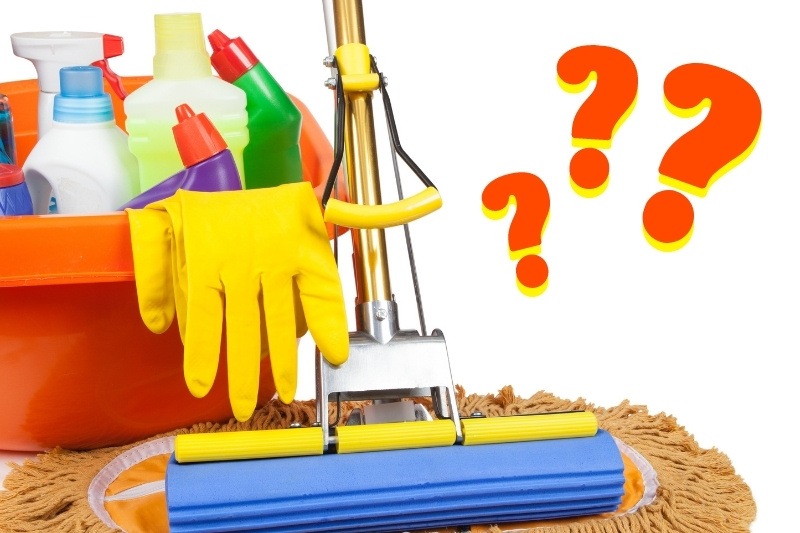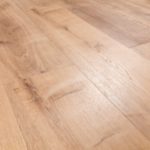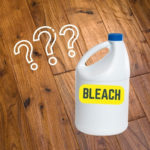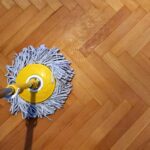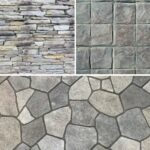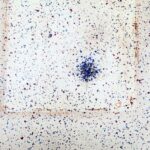With an abundance of mops and cleaning solutions available to buy, it can be tiring trying to decide what you actually need to clean your floors with. Well, you’ve come to the right place!
Find out what to mop floors with below.
What Do You Need to Mop a Floor?
When it comes to mopping a floor, you will need the following items at a minimum:
- A mop
- Some cleaning solution
- A bucket/spray bottle
- Water
There are, of course, many different mops you can buy, as well as several cleaning solutions to try out. Let’s take a look at what exactly you need to get in more detail.
Note: Choose the items that are most suitable for the type of floor you have because not all items will apply to every floor.
1. Buckets
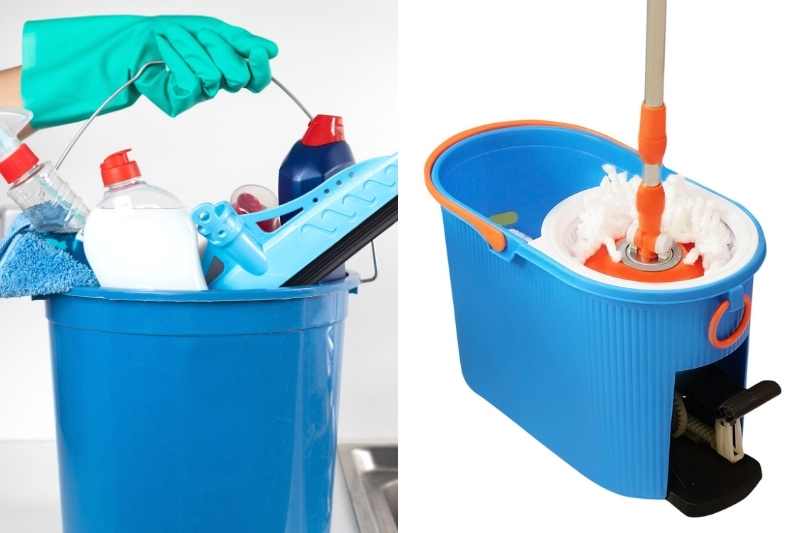
When mopping a floor, it’s worth having two buckets at hand to help you through the cleaning process.
One bucket will be used to hold your cleaning solution and the second bucket will be used to hold clean warm water.
The solution filled bucket is the one that you’ll dip your mop into when you need to clean the floor. And the second bucket of fresh water is the one you’ll dip your mop into to clean the dirt off it.
Dipping the mop in the second bucket of water stops you from dirtying and contaminating the cleaning solution.
In addition to the above, you should use buckets with wringers on them. The wringer will squeeze excess liquid out of the mop head, so you don’t soak your floors.
Note: You won’t always need to use buckets because not all floors can be or should be cleaned with lashings of water.
2. Mop
When picking out a mop to use, consider what type of floor you’re going to be cleaning. Are you cleaning tile, wood or laminate, for example. Check out the mops below.
A lot of shops sell mop and bucket sets, so keep an eye out for deals. Read our guide to the the best mop and bucket sets for some recommended products.
Sponge mop
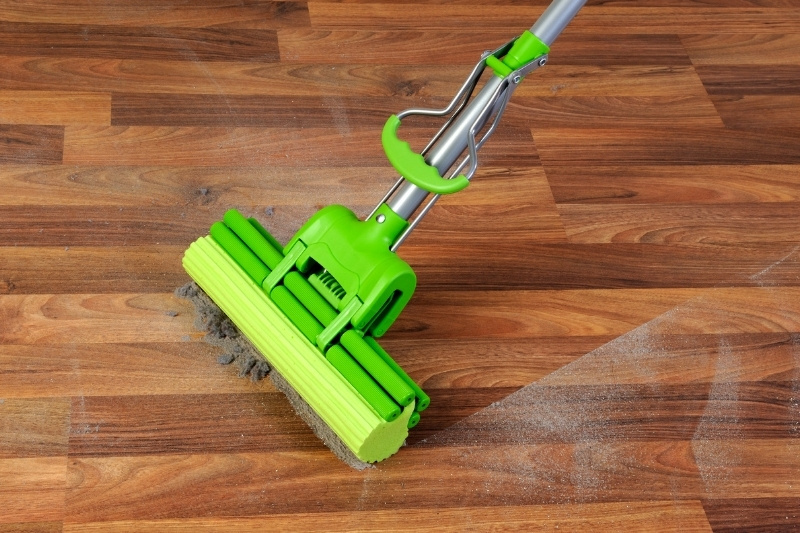
Best for: Untextured floors, like wood and laminate.
A sponge mop is a great mop to use when cleaning floors that shouldn’t get too wet because you can squeeze a lot of the liquid out of the head.
This type of mop usually works best on smoother surfaces, and overall, they can clean surfaces quite well.
Sponge mops can also be used to extractor moisture off the floor. So, an ideal mop to have around if you’ve got to mop up spills.
String mop
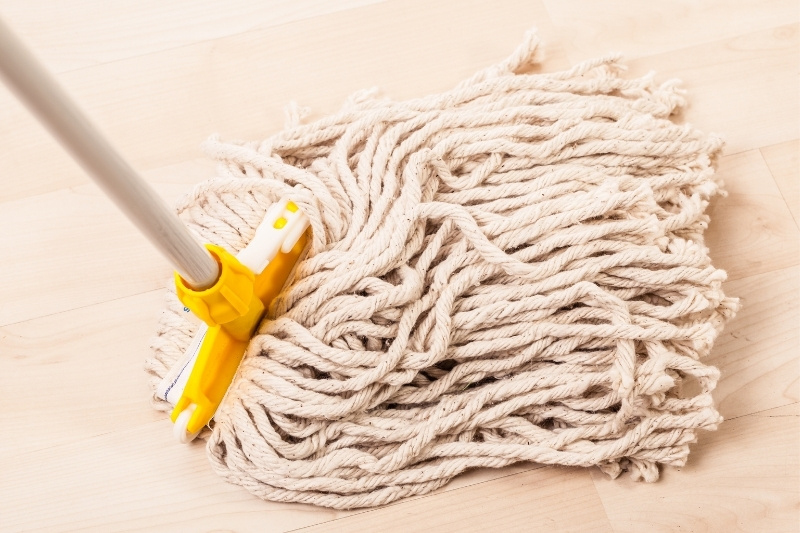
Best for: Textured floors like tile.
A string mop is the type of mop you think of when someone says ‘mop’. It’s the most traditional kind of mop around today, and it has a head made up of several thick cotton strings.
String mops have a tendency to hold more water in comparison to other mops, and it’s for this reason they shouldn’t be used on hardwood and laminate floors.
That being said, this type of mop is an effective cleaner because it can reach into smaller crevices, so ideal for textured floors.
You must, however, make sure that you rinse the head of the mop clean before you store it/use it again. A stringy mop head can be a haven for bacteria.
Flat/Pad mop
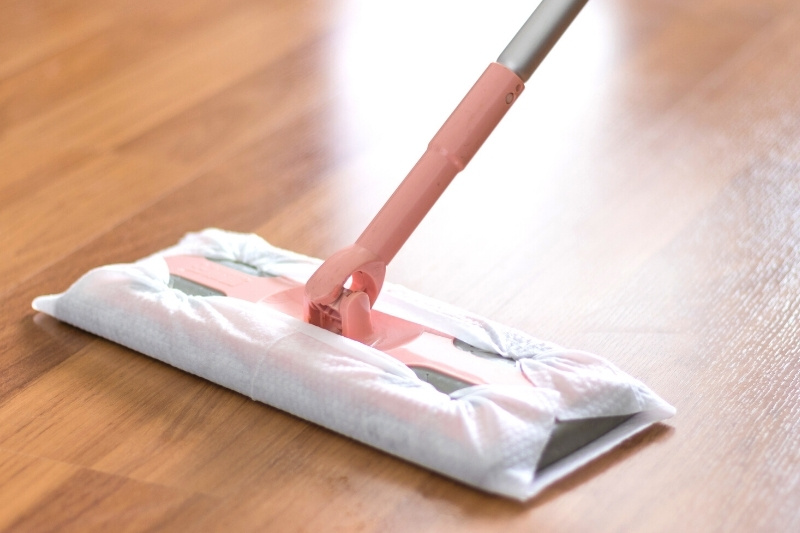
Best for: Laminate and hardwood.
Flat headed mops are usually rectangular in shape, and you can normally add a disposable cloth onto the head, or stick a washable cloth onto it instead.
These mops are best for laminate and hardwood floors because they’re not very wet, so they won’t cause too much damage to these floors.
To use this type of mop you can either spray a cleaning solution onto the head and mop the surfaces. Or you can attach a purpose made damp cloth onto the head and sweep the floors.
It’s incredibly simple, and to some extent, is a far tidier way of cleaning. There’s no real need for a bucket and gallons of water.
In addition to this, if you pick up a mop that comes with a washable cloth, you’ll be able to wash the cloth before you use it again.
This is one way of making sure the mop is free from as much bacteria as possible and it’s greener.
Microfibre mop
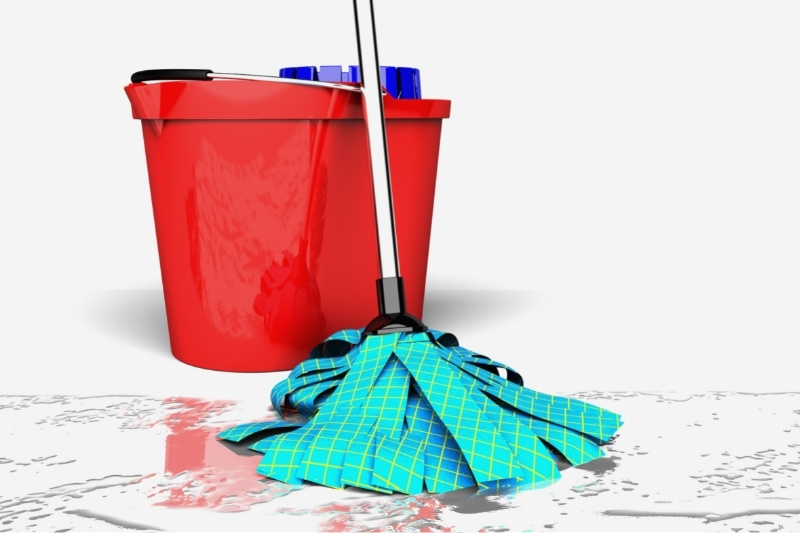
Best for: Hard floors including hardwood and laminate.
Microfibre mops don’t need to be soaked in water to work effectively because they’re naturally great at trapping dirt and dust. This kind of mop also glides across floors with ease too, so the cleaning job can feel a tad easier.
In addition to this, if you use a tiny amount of cleaning solution and this type of mop on hardwood and laminates, the microfibre material will leave a streak-free finish on the surfaces.
Interestingly, if you need to sweep your floors in between cleans you can use one of these mops to gather up the dirt.
Strip mop
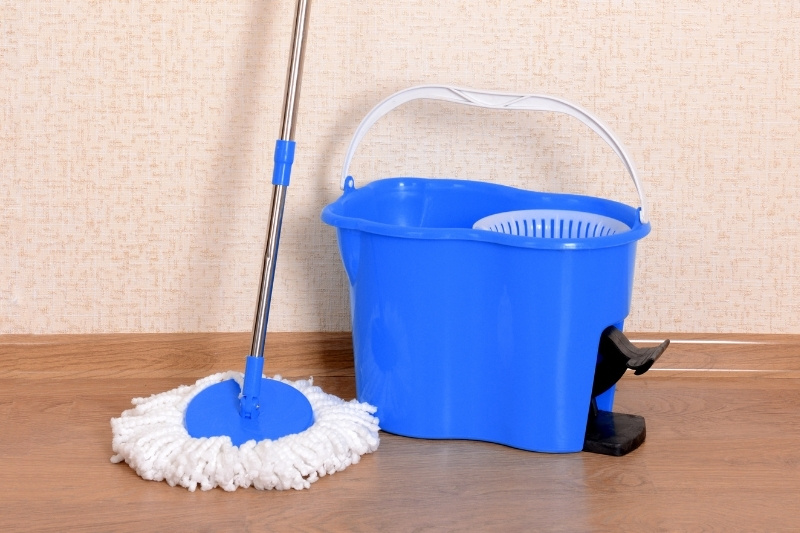
Best for: Textured floors, like tile.
A strip mop looks similar to a string mop, but instead of having cotton coming out of the head, you get thick strips of synthetic material.
These mops are great at gathering up dust, and like microfibre mops, they can also be used when dry to sweep floors. They’re usually used on more water-friendly floors and typically come with a bucket.
Steam mop

Best for: Textured floors, like tile, but not laminate or hardwood.
A steam mop is a powered mop that cleans and removes germs from floors. These mops sort of resemble regular mops in the sense that they’ve got a head (microfibre in this case), a body and a handle. However, the key differences are that steam mops have steam jets and a water reservoir.
Steam mops work by pumping intense steam through a number of jets in the machine’s head and onto a microfibre cloth.
The microfibre cloth then absorbs the steam and starts to get damp. As the microfibre cloth makes contact with a surface, it picks up the dirt and sanitises the area.
Floors are usually left with a glowing, streak-free finish after being cleaned by such a device.
However, it’s worth keeping in mind that steam mops are much more expensive to buy in comparison to the more traditional mops mentioned above.
They’re also not suitable for a lot of floors, like wood and laminate ones, because the steam can damage the surfaces.
3. Cleaning solution
When it comes to picking a cleaning solution you’ve got a few options; you can buy an off-the-shelf cleaner or you can make your own potion.
Note: You need to make sure that you use a cleaning solution that is suitable for your floor type.
In addition to this, it’s always best to use the least amount of cleaning solution and water to clean floors.
This will limit solution build up on the surface and it also protects the floor from liquid-related damage.
Tip: Always do a patch test!

Vinegar
Vinegar’s acidic nature means that it can cut through general dirt with ease, which is why it is widely used in cleaning.
It’s typically added to water in a bucket, or is part of a sprayable cleaning solution. It can, therefore, be used with most mops.
You should avoid using vinegar on natural stone surfaces as the vinegar’s acidity can cause damage.
Washing up liquid
Washing up liquid mixed with water is a very traditional floor cleaning solution. And you don’t need to use a huge amount of soap to wash surfaces, in fact, just a few drops is enough.
Generally, this solution is used with string, sponge and strip mops, but if need be, you can make a sprayable solution version too to use with flat and microfibre mops.
You must remember to rinse the floor when you’re done, otherwise you’ll end up with streaky residue on your floor.
For an added kick, you can add some vinegar to a washing up liquid and water mix. The vinegar will act as a disinfectant and will make your floors more hygienic.
Scented oil
Scented oil can be added to homemade cleaning recipes to neutralise the smell of other products, like vinegar.
Lemon juice
Like scented oils, you can add lemon juice to a homemade cleaning solution recipe to mask a poor smell.
Specialised cleaning solution
If you’d prefer to buy an official cleaning solution for your floor, you can purchase such specialised cleaners from a number of retailers, both online and offline.
Just make sure you know exactly what your floor is made of, and take note of where or not it is sealed or not.
And always double check the packaging of your chosen cleaning solution just to make sure it’s suitable for your floor.
How to choose what cleaning solution to use
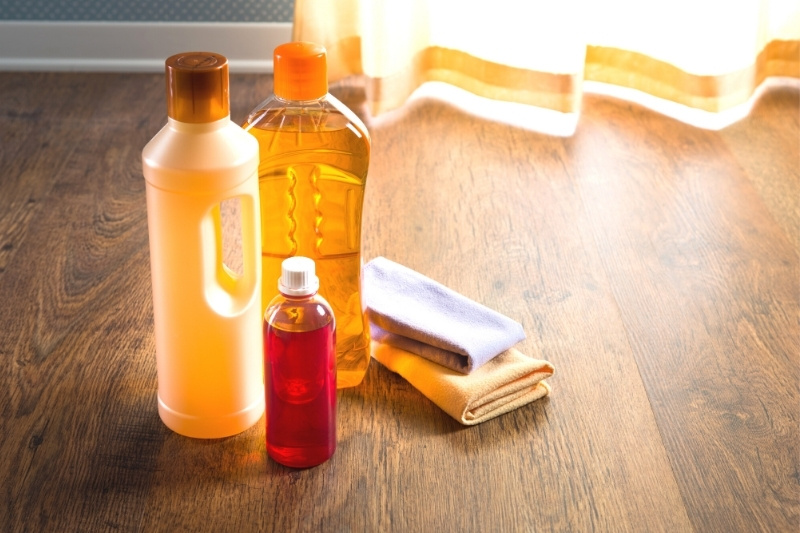
What cleaning solution you use to mop your floor depends on what type of floor you have.
Ideally, the manufacturer of your floor should’ve given you some tips and told you what cleaning products to use.
If not, try your best to stick to more natural cleaning solutions or buy a specialised floor cleaner.
Here are some ideas for you:
- Sealed hardwood, waxed or laminate flooring – For these floors, you can mix washing up liquid and warm water in a sprayable bottle and squirt this onto a mop head and clean the floors. Make sure you don’t oversaturate your floors in water. And spot cleaning as and when you need to is better.
- Ceramic tile – If you’ve got floors made from ceramic tile you can clean them with washing up liquid and warm water, or white vinegar and warm water.
- Vinyl – If you’ve got vinyl flooring, you can use washing up liquid and warm water or apple cider vinegar and warm water to clean them.
- Stone – If your floor is made from stone don’t use harsh chemicals, just use washing up liquid and warm water.
4. Water
Water is typically mixed with another product to create a cleaning solution. For example, you can mix water with washing up liquid, and many specialised floor cleaners have to be diluted in water before they’re used.
It’s important not to wash floors in too much water though as liquid can damage some floors, and it can also make floors very slippery.
5. Vacuum cleaner
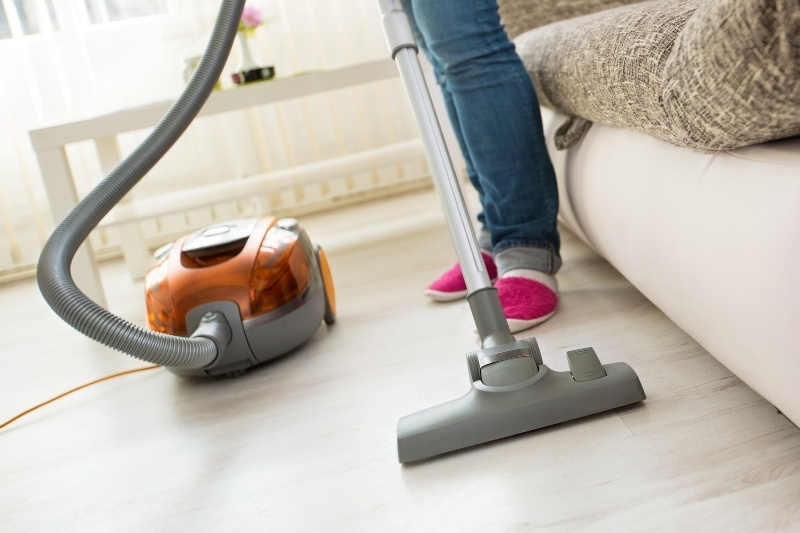
A vacuum cleaner is usually used to clean and gather up dirt form surfaces before a wet clean takes place.
It’s easier to remove things like hair when a floor is dry than when it’s wet.
Tip: Swap your vacuum cleaner’s head to suit the floor you’re hoovering. This’ll prevent scratching.
6. Dustpan and brush
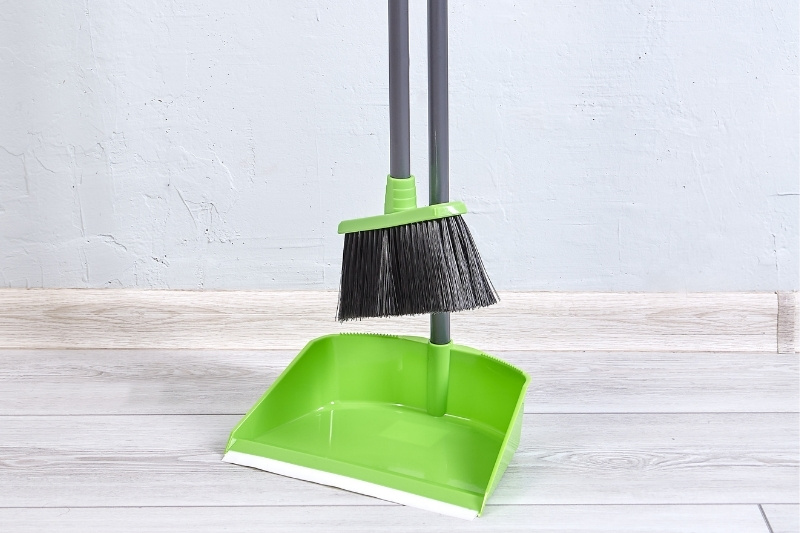
Similar to a vacuum cleaner, a dustpan and brush can be used before a wet clean takes place to collect dirt from a floor.
7. Spray bottle
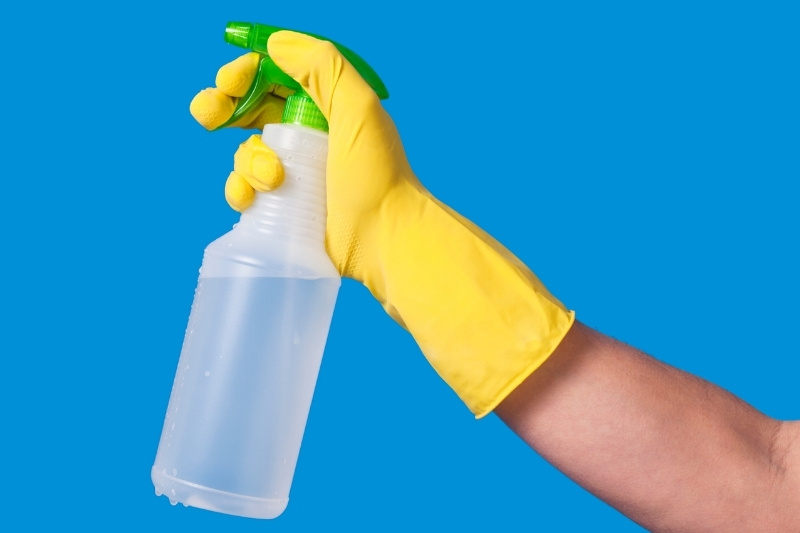
Spray bottles come in handy when you want to create a sprayable cleaning solution to clean floors that shouldn’t get too wet.
Sprayable cleaning solutions, like a vinegar and water one, can be sprayed directly onto mop heads, like microfibre and flat headed mops.
This allows you to control how much fluid goes onto the floor, so you avoid soaking the surface. This protects the floor from damage, yet it still gets cleaned properly.
What to Disinfect Floors With

Vinegar is a great alternative to off-the-shelf cleaners. Given the fact that vinegar is acidic in nature it can cut through grime and general dirt with ease.
Although, if buying a specialised disinfectant is for you, Dettol offers a range of disinfectant liquids and wipes that can be used to sanitise floors. (Always test a product before you use it).
In addition to this, steam mops can also get rid of germs. But do keep in mind that these mops cannot be used on all types of flooring.
Tips for Mopping Floors

Below you’ll find a few tips to keep in mind when mopping any sort of floor:
- Always follow the washing instructions outlined by the floor’s manufacturer.
- Test the cleaning solution you intended on using before cleaning the entire floor.
- Don’t oversaturate floors with water.
- Make sure your floors are sealed before you clean them with water. If they’re not sealed, use a pad-headed/microfibre mop to clean the floors because these mops don’t need to be soaking wet to work effectively.
In addition to this, if your floors aren’t sealed you can create a sprayable cleaning solution and spray this onto a mop head, and clean the floor like this instead. You’re less likely to saturate the floor if you do this. - Remember that not all floors can be mopped with water.
- Floors can be very slippery after they’ve been mopped, so take care when walking.
- Try and wipe your cleaned floors with a soft cloth to mop up any residue.
- Don’t use vinegar on slate, marble and granite.
- When mopping, mop from one end of the room and towards the door – you won’t step on your freshly cleaned floor then.

Bethan has a passion for exploring, reading, cooking and gardening! When she’s not creating culinary delights for her family, she’s concocting potions to keep her house clean!
